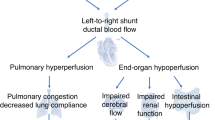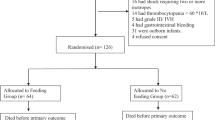Abstract
OBJECTIVE:
Enteral feeds are often discontinued or reduced during indomethacin treatment for patent ductus arteriosus (PDA) in preterm neonates, but the clinical impact of this practice is unknown. The objective of this study was to study the associations between enteral feed volume at the time of indomethacin therapy in preterm neonates with PDA and subsequent gastrointestinal outcomes.
STUDY Design:
Retrospective cohort study. Single-center level III Neonatal Intensive Care Unit.
RESULTS:
All consecutive preterm neonates who had received treatment with indomethacin for PDA over a 5-year period were included and categorized based on enteral feed volume exposure during treatment (Group A: nil per oral (NPO, N=229); Group B: ⩽60 ml kg−1 day−1 (N=142); Group C:>60 ml kg−1 day−1 (N=44)). Baseline characteristics and clinical outcomes were compared between the three groups. The primary outcome was necrotizing enterocolitis (NEC) ⩾stage IIa, while secondary outcomes included other gastrointestinal complications and common prematurity-related morbidities. Group C had a higher gestational age (mean±s.d.; A: 26.3±1.8; B: 26.1±1.8; C: 27.0±2.0 weeks), birth weight (A: 864±239; B: 847±202; C: 932±234 g) and postnatal age at the time of indomethacin treatment (A: 5.3±2.9; B: 7.2±4.9; C: 15.4±6.6 days). All groups had similar rates of the primary outcome NEC (A: 6.1%, B: 7.8% and C: 4.6%, respectively). They also had similar rates of the secondary outcomes with the exception of days to reach enteral feeds of 120 ml kg−1 day−1 (A: 22.8±8.5; B: 20.5±8.6; C: 16.8±7.7; P<0.05 for all inter-group comparisons). Secondary analysis including only those neonates who were not already NPO before indomethacin treatment (N=261) and categorized based on preemptive management (made NPO; enteral feed volume reduced; enteral feed volume unchanged/increased) also showed similar results.
Conclusions:
This large retrospective study did not identify any association between enteral feed volumes during indomethacin treatment or preemptive reduction in enteral feeds and subsequent incidence of adverse gastrointestinal outcomes in preterm neonates. Preemptive reduction in enteral feed volume was associated with longer time to reach full enteral feeds.
This is a preview of subscription content, access via your institution
Access options
Subscribe to this journal
Receive 12 print issues and online access
$259.00 per year
only $21.58 per issue
Buy this article
- Purchase on Springer Link
- Instant access to full article PDF
Prices may be subject to local taxes which are calculated during checkout
Similar content being viewed by others
References
McCurnin D, Clyman RI . Effects of a patent ductus arteriosus on postprandial mesenteric perfusion in premature baboons. Pediatrics 2008; 122: e1262–e1267.
Coombs RC, Morgan ME, Durbin GM, Booth IW, McNeish AS . Gut blood flow velocities in the newborn: effects of patent ductus arteriosus and parenteral indomethacin. Arch Dis Child 1990; 65: 1067–1071.
Laudignon N, Chemtob S, Bard H, Aranda JV . Effect of indomethacin on cerebral blood flow velocity of premature newborns. Biol Neonate 1988; 54: 254–262.
Christmann V, Liem KD, Semmekrot BA, van de Bor M . Changes in cerebral, renal and mesenteric blood flow velocity during continuous and bolus infusion of indomethacin. Acta Paediatr 2002; 91: 440–446.
Fowlie PW, Davis PG, McGuire W . Prophylactic intravenous indomethacin for preventing mortality and morbidity in preterm infants. Cochrane Database of Syst Rev 2010, Issue 7. Art. No.: CD000174. doi:10.1002/14651858.CD000174.pub2.
Jhaveri N, Soll RF, Clyman RI . Feeding practices and patent ductus arteriosus ligation preferences-are they related? Am J Perinatol 2010; 27: 667–674.
Clyman R, Wickremasinghe A, Jhaveri N, Hassinger DC, Attridge JT, Sanocka U et al. Enteral feeding during indomethacin and ibuprofen treatment of a patent ductus arteriosus. J Pediatr 2013; 163 (2): 406–411. e4.
Fenton TR, Kim JH . A systematic review and meta-analysis to revise the Fenton growth chart for preterm infants. BMC Pediatr 2013; 13: 59.
Kliegman RM . Neonatal necrotizing enterocolitis: implications for an infectious disease. Pediatr Clin North Am 1979; 26: 327–344.
Jobe AH, Bancalari E . Bronchopulmonary dysplasia. Am J Respir Crit Care Med 2001; 163: 1723–1729.
International Committee for the Classification of Retinopathy of Prematurity. The International Classification of Retinopathy of Prematurity revisited. Arch Ophthalmol 2005; 123: 991–999.
Kelleher J, Salas AA, Bhat R, Ambalavanan N, Saha S, Stoll BJ et al. Prophylactic indomethacin and intestinal perforation in extremely low birth weight infants. Pediatrics 2014; 134: e1369–e1377.
Yanowitz TD, Reese J, Gillam-Krakauer M, Cochran CM, Jegatheesan P, Lau J et al. Superior mesenteric artery blood flow velocities following medical treatment of a patent ductus arteriosus. J Pediatr 2014; 164: 661–663.
Pezzati M, Vangi V, Biagiotti R, Bertini G, Cianciulli D, Rubaltelli FF . Effects of indomethacin and ibuprofen on mesenteric and renal blood flow in preterm infants with patent ductus arteriosus. J Pediatr 1999; 135: 733–738.
Acknowledgements
We thank Junmin Yang, statistician in Mother and Infant Care Program of Mount Sinai Hospital, Toronto, ON, Canada for performing the statistical analysis for this study and Josie Chundamala, scientific editor at Mother and Infant Care Program of Mount Sinai Hospital, Toronto, ON, Canada for proofreading the manuscript.
Author information
Authors and Affiliations
Corresponding author
Ethics declarations
Competing interests
The authors declare no conflict of interest.
Rights and permissions
About this article
Cite this article
Louis, D., Torgalkar, R., Shah, J. et al. Enteral feeding during indomethacin treatment for patent ductus arteriosus: association with gastrointestinal outcomes. J Perinatol 36, 544–548 (2016). https://doi.org/10.1038/jp.2016.11
Received:
Revised:
Accepted:
Published:
Issue Date:
DOI: https://doi.org/10.1038/jp.2016.11
This article is cited by
-
The dilemma of feeding during the treatment of patent ductus arteriosus with oral ibuprofen in preterm infants ≤30 weeks of gestation—a randomized controlled trial
Journal of Perinatology (2023)
-
Nutrition with a patent ductus arteriosus: feast, feed, or famine?
Pediatric Research (2023)



